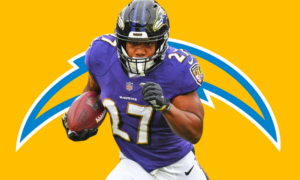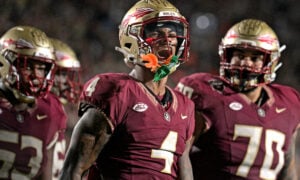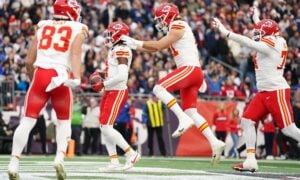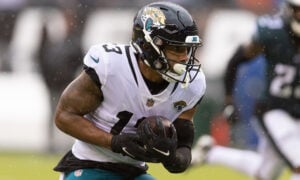Analyzing Quarterback Matchups
Playing quarterback matchups probably doesn’t work
But you should roster two cheap ones anyway
I’ve never paid up for quarterback, especially in dynasty. The reason was simple: I knew I could grab a couple cheap veterans, play matchups, and put up QB5 numbers at QB10-15 prices. So you can imagine my surprise when I read Adam Harstad’s article debunking that strategy and showing that owners — even sophisticated ones — can’t consistently get top-12 production from a pair of non-top-12 quarterbacks.
But that couldn’t be the whole story. Maybe we can’t make a silk purse from a pair of sow’s ears, but surely we can gain some advantage from considering our quarterbacks’ matchups. I set out to prove just that.
[am4show have=’g1;’ guest_error=’sub_message’ user_error=’sub_message’ ]
First, I compiled every quarterback fantasy performance from 2000 to 2014.[1] Then I used the odd-numbered seasons to create two models.[2] The first model (“QB”) included only two factors: the quarterback’s (1) season-to-date fantasy points per game; and (2) previous season’s fantasy points per game. The second model (“QB/Def”) included those two factors, plus the weekly opponent’s year-to-date fantasy points allowed. Within each model, year-to-date numbers were weighted more heavily in later weeks, while the previous season’s numbers were weighted less. In the QB/Def model, the opponent’s year-to-date numbers were weighted about half as much as the quarterback’s.
I tested the model against actual quarterback performance in even-numbered seasons. I created thousands of randomized quarterback pairings and used the model to predict which quarterback would be the better fantasy start. The results: playing matchups mattered! The QB/Def model outperformed the QB model … by one or two fantasy points per season. So, crap.
But don’t despair: I’m not going full Kenny Darter on you. My analysis hinted at another advantage — one that I hadn’t considered, but should have. You see, both the QB and QB/Def models were 95% as good as just picking the quarterback who ended up scoring more points on the season. And quarterback scoring is surprisingly unpredictable from season to season. So rostering two apparently middling quarterbacks might give us pretty good odds of landing a guy who puts up a top-12 season, and either model should give us about 95% of that production. So I set out (less optimistically) to test that approach.
Testing this was a bit easier. I compiled the top 24 quarterbacks from 2006 to 2015 by redraft average draft[3] position and their fantasy points per game[4] for that season. I then adjusted each season to 2015 quarterback fantasy scoring by multiplying each quarterback’s points-per-game by the 2015 top-24 average and dividing by his season’s top-24 average (to allow for cross-season comparisons). Then, I bucketed them by positional ADP (“Top 3”; “4 to 6”; “7 to 9” … “22 to 24”) and created tens of thousands of random pairings between players in various buckets and averaged the average maximum points per game for each bucket pairing. For example, 2014 Matt Ryan was the eleventh quarterback drafted, so he fell in the “10 to 12” bucket; 2009 Donovan McNabb was the eighth quarterback drafted, so he fell in the “7 to 9” bucket. If they were randomly paired together, McNabb’s 20.7 adjusted points per game would beat Ryan’s 19.9 adjusted points per game, so only McNabb’s points would count toward the average.
Here are the results, in visual form, for “solo” quarterbacks, those paired with the sixteenth to eighteenth drafted quarterbacks, and those paired with the twenty-second to twenty-fourth drafted quarterbacks.
[1] Thanks, www.armchairanalysis.com
[2] Creating each model was a multi-step process. First, I ran a regression for each set of quarterback games (from 2 to 16) to identify the predictive weight of each variable in each week. Then, I created a best fit (logarithmic) curve to determine how to adjust the relative weights of season-to-date and previous season numbers over time. I assumed the relative value of quarterback season-to-date and opponent season-to-date numbers would remain constant.
[3] Thanks, www.myfantasyleague.com/adp-rankings/
[4] Thanks, www.pro-football-reference.com
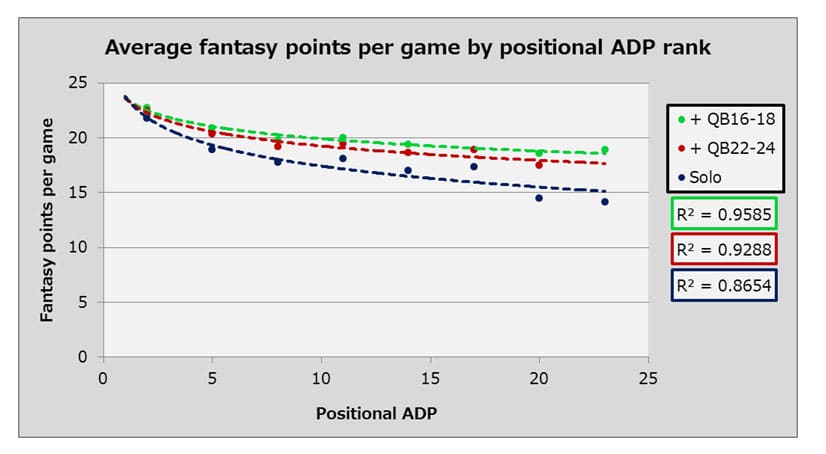
As you can see, adding a second quarterback, even a low-end backup, dramatically flattens the curve. That is to say, later-drafted quarterbacks become much more valuable relative to higher-drafted ones.
And here’s a full chart of each bucket pairing. Note that I did not pair any bucket with itself because I couldn’t easily prevent a quarterback being matched with himself (and thus losing the advantage of pairing). In dynasty, these “paired” numbers are more relevant because competitive teams are rostering at least one competent backup quarterback in all but the shallowest (or deepest) leagues.
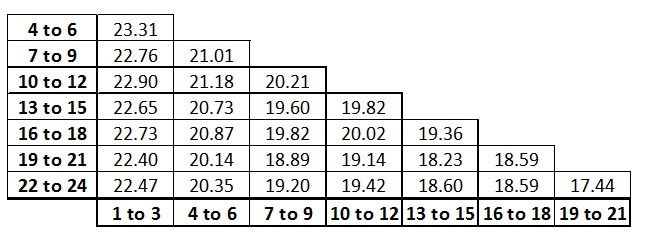
While you can’t create an elite quarterback from any other combination, you can get close for cheap. For example, pairing an expected low-end starter and high-end backup yields 19.82 points per game — within three points per game of an owner rostering an expected high-end starter and low-end (or even middling) backup, and at a fraction of the price. True, we should expect only 95 percent of that production in our lineup, but the owner rostering a high-end starter is also going to suffer more than we will during bye weeks and when the starter is injured. So it’s tough to tell how much of that 5 percent is really lost. And by week 14 when the games really start to matter, we’ll almost certainly have identified which quarterback from our pair is the go-to guy, so that 5 percent evaporates.
Sure, it stinks that we probably can’t gain much advantage by playing quarterback matchups, especially since I’m on record saying we can. But because of season-to-season variance in quarterback scoring, you can still set yourself up for success by passing on the nerdy guy with a scraggly beard in the third round and grabbing the nerdy guy with a luxurious beard in the 18th.
[/am4show]
- Dynasty Capsule: Miami Dolphins - January 26, 2019
- Dynasty Capsule: Buffalo Bills - January 21, 2019
- Dynasty Capsule: Carolina Panthers - January 21, 2018





